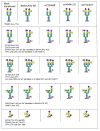Glycoproteomic and Phenotypic Elucidation of B4GALNT2 Expression Variants in the SID Histo-Blood Group System
- PMID: 35409292
- PMCID: PMC8999409
- DOI: 10.3390/ijms23073936
Glycoproteomic and Phenotypic Elucidation of B4GALNT2 Expression Variants in the SID Histo-Blood Group System
Abstract
The Sda histo-blood group antigen (GalNAcβ1-4(NeuAcα2-3)Galβ-R) is implicated in various infections and constitutes a potential biomarker for colon cancer. Sd(a−) individuals (2−4% of Europeans) may produce anti-Sda, which can lead to incompatible blood transfusions, especially if donors with the high-expressing Sd(a++)/Cad phenotype are involved. We previously reported the association of B4GALNT2 mutations with Sd(a−), which established the SID blood-group system. The present study provides causal proof underpinning this correlation. Sd(a−) HEK293 cells were transfected with different B4GALNT2 constructs and evaluated by immunostaining and glycoproteomics. The predominant SIDnull candidate allele with rs7224888:T>C (p.Cys406Arg) abolished Sda synthesis, while this antigen was detectable as N- or O-glycans on glycoproteins following transfection of wildtype B4GALNT2. Surprisingly, two rare missense variants, rs148441237:A>G and rs61743617:C>T, found in a Sd(a−) compound heterozygote, gave results similar to wildtype. To elucidate on whether Sd(a++)/Cad also depends on B4GALNT2 alterations, this gene was sequenced in five individuals. No Cad-specific changes were identified, but a detailed erythroid Cad glycoprotein profile was obtained, especially for glycophorin-A (GLPA) O-glycosylation, equilibrative nucleoside transporter 1 (S29A1) O-glycosylation, and band 3 anion transport protein (B3AT) N-glycosylation. In conclusion, the p.Cys406Arg β4GalNAc-T2 variant causes Sda-deficiency in humans, while the enigmatic Cad phenotype remains unresolved, albeit further characterized.
Keywords: SID blood group system; carbohydrate biosynthesis; erythrocyte; flow cytometry; gene expression; glycobiology; glycopeptide; glycoprotein; glycosyltransferase; mass spectrometry (MS).
Conflict of interest statement
The authors have no conflict of interest in relation to this study.
Figures







References
-
- Veldhuisen B., Ligthart P., van der Mark-Zoet J., Javadi A., Tissoudali A., Dengerink I., Folman C., van der Shoot C.E. Identification of a single homozygous mutation in the B4GALNT2 gene in individuals lacking the Sd(a) (SID) antigen on red blood cells. Vox Sang. 2019;114:193.
-
- Macvie S.I., Morton J.A., Pickles M.M. The reactions and inheritance of a new blood group antigen, Sda. Vox Sang. 1967;13:485–492. doi: 10.1111/j.1423-0410.1967.tb03795.x. - DOI
-
- Renton P.H. Anti-Sda new blood group antibody. Vox Sang. 1967;13:493–501. doi: 10.1111/j.1423-0410.1967.tb03796.x. - DOI
MeSH terms
Substances
Grants and funding
LinkOut - more resources
Full Text Sources
Molecular Biology Databases
Miscellaneous

